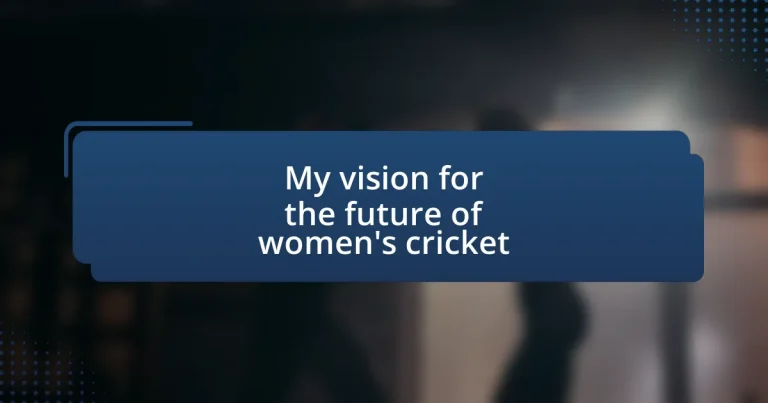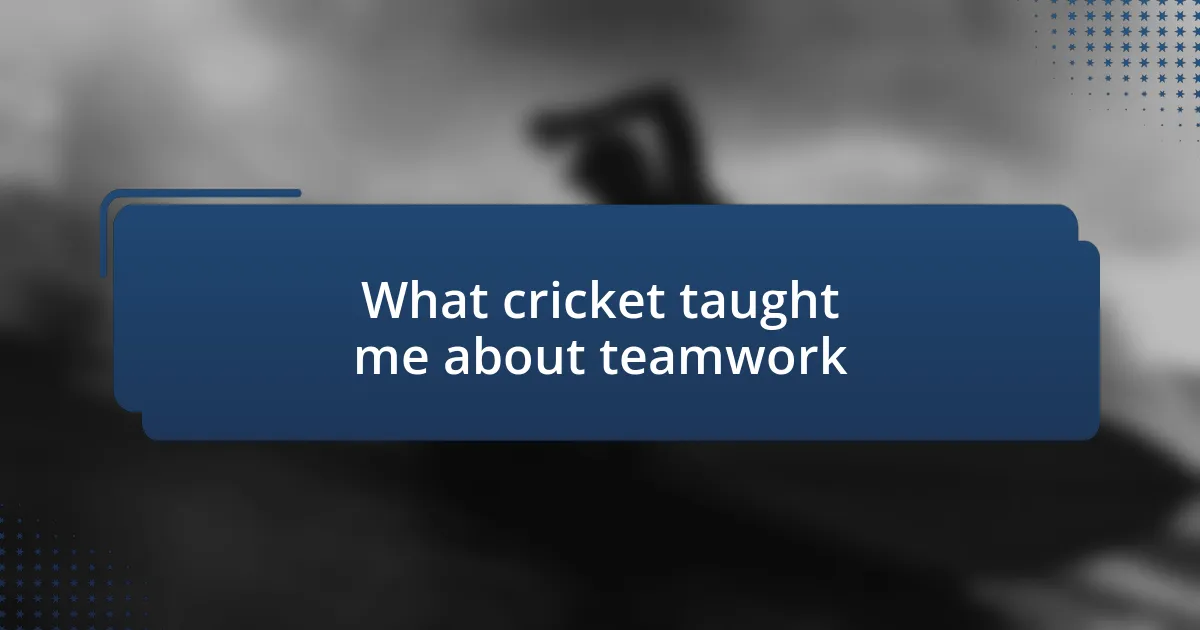Key takeaways:
- Women’s cricket has seen significant growth in visibility and support, highlighted by events like the 2017 Women’s World Cup final.
- Challenges remain, including disparities in resources, societal stereotypes, and limited career opportunities for female cricketers.
- Strategies for promoting women’s cricket include enhancing media coverage, developing youth programs for girls, and fostering partnerships with women’s organizations.
- Future goals focus on investing in professional pathways, increasing media visibility, and enhancing international competition to support women’s cricket growth.

The evolution of women’s cricket
Women’s cricket has come a long way since its inception. When I first started following the sport in the early 2000s, I remember watching matches that were often overshadowed by their male counterparts. Back then, I often wondered why women’s cricket lacked the same fanfare and support. The gradual rise in visibility, especially with landmark events like the Women’s World Cup and the introduction of the T20 format, has been nothing short of thrilling.
I’ll never forget the 2017 Women’s World Cup final at Lord’s. It was a turning point; the stadium was packed, and millions tuned in to watch England defeat India. For the first time, I felt a palpable shift in energy. It sparked conversations in my circles about female athletes, who had usually been relegated to the sidelines. Have you felt that change too? It’s as if a door has been opened, allowing us to fully appreciate the incredible talent and stories of these athletes.
As time goes on, we witness an increasing recognition of the importance of women’s participation in sports. The gap in funding and resources is slowly closing, and more young girls see cricket as a viable career option. I often reflect on the young girls I mentor, who are now more inspired than ever to pick up a bat and ball. It’s heartening to think about what the future holds for women in cricket; the journey is still unfolding, and I am excited to witness the next chapters in this wonderful evolution.

Current state of women’s cricket
The current state of women’s cricket reflects a growing momentum that I find both inspiring and hopeful. Women’s matches are now garnering more media coverage and fan engagement, which was hardly the case a decade ago. I fondly recall attending a local women’s match last summer and being surprised by the enthusiastic crowd cheering passionately for their teams—it’s moments like these that confirm the rising popularity of the sport.
Here are some noteworthy aspects of the current landscape in women’s cricket:
- Increased media visibility, with major broadcasters now dedicating airtime to women’s tournaments.
- Growing sponsorship deals that are on par with those in men’s cricket, enhancing financial support for players and leagues.
- Expansion of domestic leagues, like the Women’s Big Bash League and The Hundred, creating more opportunities for talent to shine.
- Increased participation rates in grassroots programs, with more young girls taking up the sport than ever before.
It’s truly rewarding to see this transformation, not just in the game itself but in the broader culture surrounding women’s sports. Each improvement feels like a small victory, and I can’t help but imagine how far we can push this momentum further.

Barriers facing women’s cricket
Barriers facing women’s cricket are still significantly challenging, despite the positive strides the sport has made. I still remember a conversation I had with a young female cricketer who spoke passionately about her love for the game. Yet, she expressed frustration over the lack of resources available for training and development. It’s discouraging to see talented players face limitations that prevent them from maximizing their potential simply because the funding isn’t allocated as it is for their male counterparts.
Another hurdle is the societal stereotypes that persist around women playing sports. I once witnessed a spontaneous reaction at a family gathering when a cousin dismissed women’s cricket as less exciting than men’s games. Moments like that highlight how pervasive these outdated beliefs can be, creating a challenge for girls who aspire to play professionally. Changing these perceptions requires concerted efforts from both the sporting community and society at large.
Moreover, the disparity in career opportunities further compounds these barriers. When I spoke with female coaches recently, they highlighted the frustration of not being able to find positions comparable to their male counterparts, despite their qualifications. This lack of visible role models and support structures can make it difficult for aspiring players to envision long-term careers in cricket.
| Barrier | Description |
|---|---|
| Resource Allocation | Insufficient funding and training facilities available for women’s teams |
| Stereotypes | Prevailing societal attitudes that undermine women’s sports |
| Career Opportunities | Limited professional opportunities compared to the men’s game |

Strategies for promoting women’s cricket
One effective strategy for promoting women’s cricket is to enhance visibility through media coverage. I recall the first time I saw a women’s match highlighted on a major sports channel. It felt like a breakthrough moment, showcasing not only the talent on the field but also the passion of the players. Increasing the frequency and quality of media coverage can inspire young girls to pursue cricket, bridging the gap between visible success and aspirational dreams.
Engaging schools and youth programs by introducing cricket clinics specifically for girls is another promising approach. When I organized a local cricket day for female students, the excitement was palpable. These events can cultivate interest from a young age, making the sport more accessible and relatable. How can we expect the next generation of female cricketers to emerge without programs designed to spark their interest?
Finally, forging partnerships with existing women’s organizations can help amplify the message. I remember attending a workshop focused on women’s empowerment in sports, which was enriched by stories from female athletes across various disciplines. Collaborative efforts can share resources and build a supportive network that uplifts women’s cricket as a whole. By working together, we can create a vibrant community that celebrates and nurtures the future of women’s cricket.

Developing youth programs for girls
Developing youth programs specifically for girls is crucial for the future of women’s cricket. I remember the thrill I felt when my niece first picked up a bat during a summer camp designed for young girls. It was empowering to see her confidence grow with each swing, highlighting how vital it is to create environments where girls can learn and enjoy the game. But how can we ensure these programs reach girls who might not otherwise have access?
It’s essential to create targeted initiatives that reach diverse communities. I once volunteered at a program in an underprivileged neighborhood. Watching girls, who had never considered cricket as an option, discover their love for the sport reminded me of the untapped potential that exists. By providing free equipment, coaching, and transport, we can remove barriers and open doors for young girls eager to experience cricket.
Another key aspect is ensuring mentorship from female role models in the sport. When I met some of the local women cricketers who volunteered to coach, the inspired expressions on the girls’ faces spoke volumes. It was a poignant reminder of how representation matters. When girls see women who have succeeded in cricket, they can envision themselves on the field. In what other ways can we foster a sense of belonging and aspiration in these young players? I’ll share that creating a supportive community among girls in cricket can make all the difference.

Future goals for women’s cricket
Investing in professional pathways for female cricketers is essential for the growth of women’s cricket. I vividly remember attending a local league match and being struck by the talent on display. Yet, it was disheartening to see many talented players working second jobs to support their passion for cricket. How can we expect these athletes to excel if we don’t provide them with the necessary financial support to pursue their dreams? Establishing sustainable contracts and sponsorships can make a world of difference.
Another crucial goal is promoting awareness and visibility of women’s cricket through media coverage. I recall the excitement that flooded social media after an incredible match featuring our local women’s team—everyone was talking about it! But why does it feel like these monumental moments get overshadowed? Increasing marketing efforts and securing prime broadcasting slots can elevate the sport and inspire the next generation of female cricketers.
Lastly, enhancing international competition through more tournaments and tours can foster growth. My heart raced during a recent international play-off; the atmosphere was electric. These events not only provide pivotal exposure but also bridge gaps between countries, creating camaraderie and shared aspirations. How can we leverage this excitement to build grassroots support for women’s cricket? By encouraging local clubs to host events and fan engagement activities, we can create a more vibrant culture around the sport.





